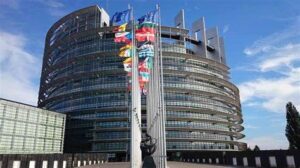
As the 9th of May is approaching, in order to commemorate Europe Day and its significance for the Member States, today’s article delves into the history of the European Union. Every 9th of May, the nations within the European Union come together to commemorate Europe Day. This significant occasion is chosen to honor the anniversary of the Schuman Declaration, widely regarded as the cornerstone of the European Union and a powerful emblem of European unity. It was on the 9th of May 1950, when Robert Schuman initiated the establishment of a pivotal European institution, crucial in fostering peace and collaboration across the continent.
The European Union (EU) constitutes a political and economic alliance of 27 countries. It encourages democratic principles within its member states and stands as one of the globe’s most influential trade unions. Nineteen nations within it adopt the euro as their official currency. The European Union emerged from a collective aspiration to fortify economic and political collaboration across the European continent following the aftermath of World War II.
History
The roots of the EU can be traced back to the establishment of the European Coal and Steel Community in 1950, consisting of just six members: Belgium, France, Germany, Italy, Luxembourg, and the Netherlands. It evolved into the European Economic Community in 1957 through the Treaty of Rome and later became known as the European Community (EC).
This transformation aimed to deepen integration among member nations in foreign, security, and internal affairs policies. In the same year, the EU initiated a common market to facilitate the free movement of goods, services, people, and capital across its internal borders.
Initially, the EC concentrated on developing a common agricultural policy and dismantling customs barriers. Denmark, Ireland, and the U.K. joined in 1973 during the first wave of expansion, with direct elections to the European Parliament commencing in 1979.
Creation of a Common Market
The creation of a unified European market began with the Single European Act in 1986, launching a six-year plan to harmonize national regulations.
The Maastricht Treaty, effective in 1993, replaced the EC with the EU, introducing the euro as a common single currency for participating members on January 1, 1999. Denmark and the U.K. secured „opt-out“ provisions allowing them to retain their respective currencies. Despite this, some newer EU members have either not met the criteria for euro adoption or have chosen to opt out. The original constituents of the European Union comprised Western European countries. Throughout the 21st century, the EU has broadened its membership to encompass Eastern European nations that arose following the dissolution of the Soviet Union. Presently, its member states from Eastern Europe consist of Bulgaria, Croatia, the Czech Republic, Estonia, Latvia, Lithuania, Poland, Romania, Slovakia, and Slovenia.
European Debt Crisis and long-term measures
The European Debt Crisis ensued after the global financial crisis of 2007-2008, with the EU and the European Central Bank grappling to address high sovereign debt and sluggish growth in countries like Italy, Spain, Portugal, Ireland, and Greece.
Greece and Ireland received financial aid from the EU in 2010, contingent upon implementing fiscal austerity measures, followed by Portugal in 2011. A second bailout for Greece was necessary in 2012. The crisis waned as the EU and the European Central Bank implemented measures to support affected countries‘ sovereign and banking-sector debts.
Long-term solutions included the establishment of the European Stability Mechanism (ESM) in October 2012 to aid EU members facing severe financial challenges. The European Central Bank also conducted several rounds of refinancing operations to provide favorable financing for EU financial institutions.
In 2015, the EU relaxed the provisions of the 2011 Stability and Growth Act, allowing member states more flexibility regarding public debt and budget deficits. That same year, the Single Resolution Board, a new EU agency, took charge of resolving bank failures in the euro area.
EU’s North-South Issues
Despite relief efforts, the EU still grapples with a fundamental issue—the economic gap between its highly industrialized north and less affluent southern regions, exacerbated by the shared currency. This disparity hinders southern economies‘ competitiveness, as they lack the advantage of currency depreciation enjoyed by their northern counterparts.
At present, the European Union persists as a symbol of unity and collaboration among nations. Despite facing challenges like economic downturns and political discord, it remains steadfast in its mission to promote peace and prosperity. As discussions on institutional reform and global issues continue, the EU stands resilient, guided by its founding principles of democracy and solidarity. While acknowledging its flaws, the EU’s commitment to cooperation offers hope for a brighter future in an uncertain world. Therefore, the 9th of May does not only remind us of the efforts in the past, but it also stands as a celebration day for peace and unity in Europe.
References
European Union . (2024). Europe Day. Retrieved from European Union : https://european-union.europa.eu/principles-countries-history/symbols/europe-day_en
Hayes, A. (2023, December 14). European Union (EU): What It Is, Countries, History, Purpose. Retrieved from Investopedia: https://www.investopedia.com/terms/e/europeanunion.asp
Photo:
OIP.XLUBZgxY41Kxjad8ExDK4gHaEK (474×266) (bing.com)



